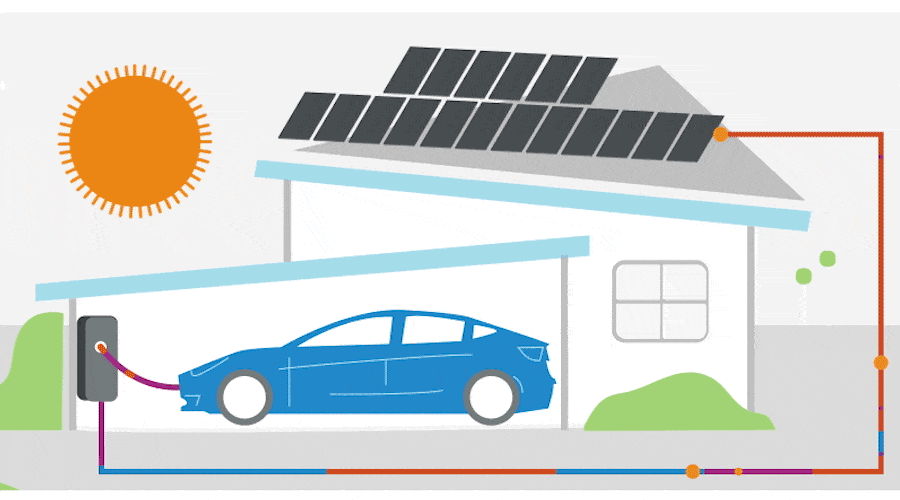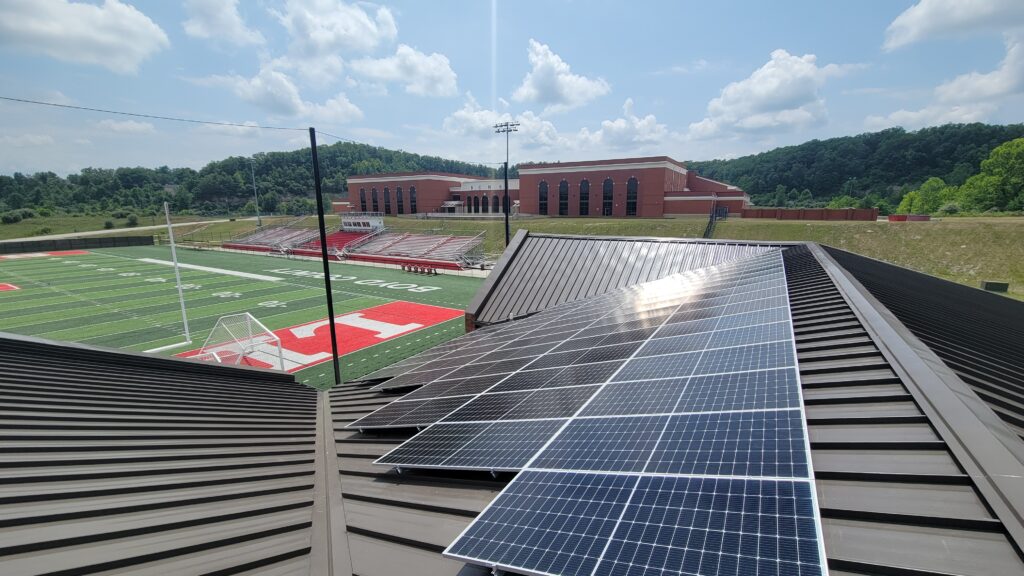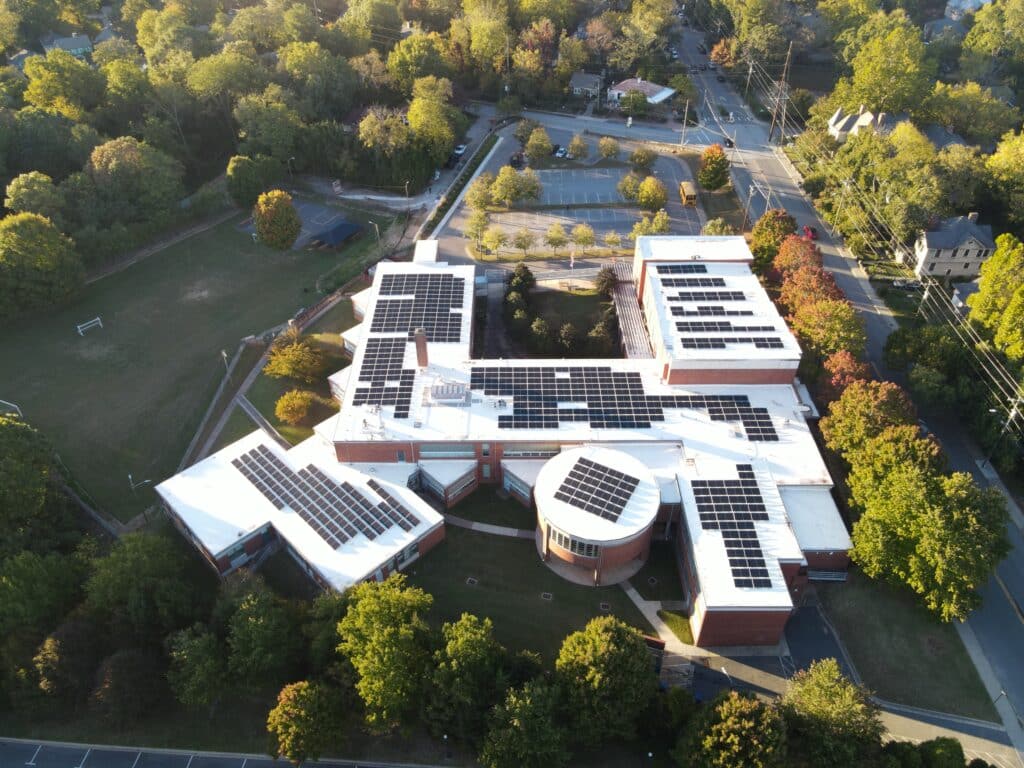We’ve written an update and expanded on this topic. Give this page a read and then check out the update.
We hear a lot these days about “going local.” We might shop at the farmers market or choose to support mom-and-pop businesses in our community. Yet when it comes to energy, we usually just flip the switch or fill up the tank, without thinking much about it. Fortunately, there are rewarding ways we can go local with our energy, too.
Two of the most exciting, game-changing local energy options today are solar power and electric cars (or electric vehicles, a.k.a. EVs). By getting electricity from our rooftops and charging our cars in the comfort of our own garages, we’re making conscious decisions as consumers to bring power (literally) back to our communities. And the best part is, we can do it today.
The solar revolution
Residential and community-based solar installations are cropping up across the country, from the sun-soaked roofs of the rural southwest to neighborhoods in Massachusetts. With the costs of solar power plummeting, solar is now the fastest growing energy source worldwide. As photovoltaic panels improve in quality and performance, the number of solar installers is skyrocketing.
Solar increasingly makes good economic sense. In Hawaii, high electricity prices led an estimated 20 percent of Hawaiian Electric customers to go solar by late 2017. In California, more than 700,000 solar arrays have been installed on residential roofs and other structures. Rooftop panels and local solar farms are quicker and cheaper to install than a utility-scale power plant and can save consumers substantial sums over time.
By getting electricity from our rooftops and charging our cars in the comfort of our own garages, we’re making conscious decisions as consumers to bring power (literally) back to our communities.
Not all states offer the financial incentives and policy support that California or Hawaii do. But across the country, federal and state regulators are opening markets to affordable, distributed renewable energy, and even utilities recognize that this is our future. In many states, feed-in tariffs and net metering policies enable independent power producers (such as households with solar) to feed their excess generation back to the grid and get compensated for it. Many states and the federal government also offer rebates and/or tax credits for installing solar.
“Local solar” is no longer an isolated trend. Every 90 seconds, a home is going solar somewhere in the U.S. During the second half of 2017 and the first half of 2018, solar power produced from rooftop arrays on homes and businesses, or in community solar gardens, provided one-fifth of new U.S. power plant capacity, according to the Institute for Local Self-Reliance.
Solar installations strengthen our local economies, not only providing savings on energy costs but creating good jobs and boosting local resilience in the face of volatile energy prices. Even with the new solar tariffs, there are still twice as many U.S. jobs in solar as in coal, according to the Solar Energy Industries Association. The Bureau of Labor Statistics predicts that over the next decade, “solar installer” will be the fastest growing job in America.

Add to this the breakthroughs in energy storage, and the allure of solar will only grow. With new battery technologies available, households with solar panels can now store their excess power for use at times when the sun doesn’t shine. These options are increasingly affordable: in Hawaii, Sunrun offers its BrightBox system—which combines solar generation with “smart inverter” technology and Tesla’s Powerwall home battery storage—for as low as 19 cents per kilowatt-hour, almost half the price of grid-based electricity. In California, roughly one in five of Sunrun’s new residential solar customers are choosing the home battery storage option.
In Vermont, Green Mountain Power offers installations of Tesla’s Powerwall for customers with rooftop solar, either through a monthly lease at no upfront cost, or by partnering on the unit’s purchase, resulting in a monthly credit on the customer’s bill. Resident Troy Turner noted in 2016: “This is a great investment for our family to increase reliability and lessen the impact of outages. We really believe this is the future of energy and are very excited to be a small part of the revolution.”
Enter electric cars
When electric cars enter the mix, the next level of energy transformation happens. Imagine meeting your household’s power needs with rooftop solar, then also plugging in your car to solar-charge it for your morning commute. You’ve eliminated the need for centralized, fossil-fueled power, as well as for gasoline. You’re saving money, reducing your carbon footprint, and supporting your local economy.
Today’s electric cars vary widely in their abilities. Some plug-in hybrids run about 40 miles on electricity and then switch to gasoline power, whereas battery-only cars can range up to 250 miles but typically go up to 115 miles. This may not sound like a lot, but it’s twice as far as the average American drives in a day. EVs not only save on fuel costs, but they are quieter, have fewer tailpipe emissions, have lower total ownership costs, and are key to reducing greenhouse gas emissions from the transport sector.
Between 2013 and 2017, nearly 652,000 plug-in EVs were added to U.S. roads. EVs account for about 1.2 percent of auto sales nationwide, but this could hit 2 percent soon with deliveries of Tesla’s Model 3, which is quickly becoming one of America’s best-selling sedans. In California, the EV share is higher—around 7.5 percent—and in 30 cities across the state it now exceeds 10 percent. As ground zero for the EV market, California is responsible for a whopping 53 percent of U.S. EV sales, but the vehicles are also popular in the northeast and in metropolitan areas of New York, Georgia, Washington, Florida, Texas, and elsewhere.
“Local solar” is no longer an isolated trend. Every 90 seconds, a home is going solar somewhere in the U.S.
As more consumers consider buying EVs, the main challenge appears to be one of supply, not demand. Of the 42 plug-in hybrid or battery-only EVs on the market, only 10 are sport-utility or crossover-utility vehicles, and none are trucks. But over the next decade, most major automakers plan to invest in or produce new EV models in more categories, and EVs could cross into the U.S. mainstream (16 percent of new vehicle sales) in as little as six to eight years.
When combined with residential solar, EVs are a true game changer for local energy. New technologies are making it easier than ever to recharge your car using renewable power from your own rooftop. In July 2017, SolarEdge launched the world’s first EV charger with a built-in solar inverter, which the company claims can charge an EV six times faster. By integrating solar power and EV charging in a single unit, SolarEdge notes, residents can “future proof” their homes, whether they own an EV now or “just want to be EV-ready.”
The local energy revolution is happening now. By embracing opportunities like community solar and electric vehicles, consumers across America are transforming not just their homes and their transportation, but how they power their lives.















